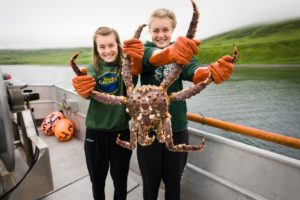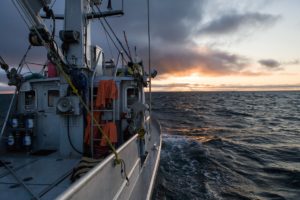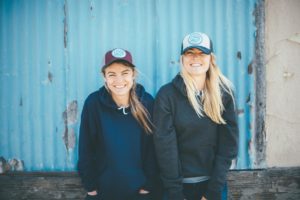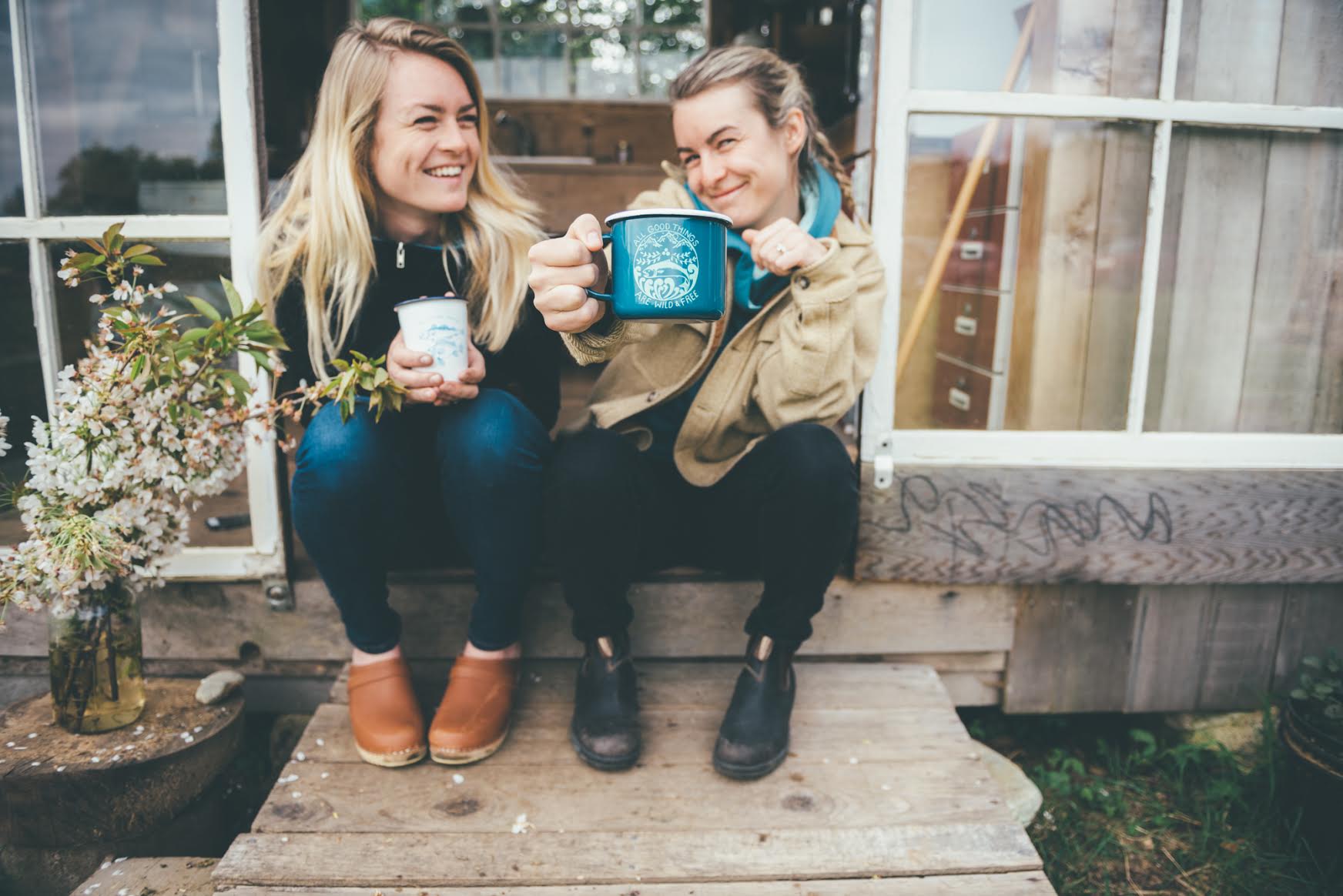AK Salmon Sisters: Commercial fishing and a love of wild spaces
Twenty-somethings Claire Neaton and Emma Teal Laukitis grew up on a family homestead near the Aleutian Islands in Alaska. Their wild upbringing has translated into a continued love of the ocean and all things fishing. You may even know the duo by their company name, AK Salmon Sisters.
AK Salmon Sisters
In college, Claire studied business administration with a minor in nutrition, while Emma earned degrees in English and fine arts.
In 2012, during their final undergraduate years, they combined passion and education to start their small business selling Alaska-themed apparel and homegoods to family and friends on Etsy.
Today, AK Salmon Sisters designs feature beautiful hand-drawn images of the state, fish and other natural features of the area and commercial fishing industry. They’ve moved past Etsy to their on web store, where you can purchase aprons that read, “All good things are wild and free” or tea towels featuring step-by-step sketches of filleting a salmon, along with other goods.
The duo also sells shares of sockeye salmon and halibut. You can’t get fish much fresher than these fillets that come via two-day shipping straight from Homer, Alaska. Each share includes some of the team’s favorite recipes and a reusable AK Salmon Sisters tote bag.
Emma noted that what some people may have labeled a passion project quickly grew into something bigger.
“It’s everything we care about – fishing, our home and our community. Keeping the future of sustainable fishing alive for other young fishermen like us and future generations.” She shared. “It’s what we’re supposed to be doing, and doing it together was a no-brainer too.”
Today, the company pairs with makers throughout Alaska and has five local people who help with daily business. Claire runs the operation year-round from Homer, while Emma is finishing up a master’s degree in design in Washington state. She drew many of the AK Salmon Sisters images that are printed onto shirts, leggings, totes and mugs.
“We’re sending our apparel to coastal communities all over the country and to remote villages all over Alaska like the one we grew up in,” Emma noted. Kodiak, Sitka and Petersburg are popular addresses when the company sends out packages. “And lots of tiny villages all over AK!” Emma exclaimed. “Those are our favorite because we know how exciting mail is when you live in bush Alaska.”
Portions of company proceeds go to the Alaska Marine Conservation Council, The Great Land Trust and The Salmon Project in an effort to improve the health of the oceans and promote thriving coastal communities. The sisters have also recently started a one-to-one program that provides a can of wild Alaskan salmon to Alaskan food banks with every product they sell.
The company’s efforts support the communities of adventurers, fishermen and ocean enthusiasts that surround and inspire the AK Salmon Sisters team.

An insider’s view of commercial fishing
On their website and social media, the sisters promote the next generation of commercial fishermen with “Young Fishermen Fridays” posts. Many of the shots include women on fishing vessels holding up the day’s catch.
“There is a large population of women who commercial fish in Alaska,” Claire said. “It is not rare to be a crewman or permit holder. There are only a handful of women who run larger boats.”
Emma added that many girls like them grew up fishing on family boats. “It’s a great job for anyone who is in high school and college when you’re out of school for the summers. We paid our way through college by fishing.”
If you have had any access to TV networks like the Discovery Channel or the Travel Channel, you’ve likely come across a few reality shows set in rural Alaska. The U.S., maybe even the world, is fascinated with the wild place that is the most Northern state in the country. These shows feature survivalist adventure races, commercial fishing for crabs and salmon and even homesteading.
Claire finds the saucy characters entertaining. She added that her homesteading experience was much more challenging and remote, but without made-up drama.
“Alaskans are quirky. They should be celebrated in whatever form that takes place,” Emma noted, adding that she hasn’t seen many Alaskan shows.
“Our homestead was really off the map. Our family was just working hard and living day-to-day, growing food for ourselves and catching fish for a living. No time or energy for camera crews,” She shared.
In the summer, the women migrate between Prince William Sound and the Aleutian islands to partake in the fishing season.
The same can’t be said for other Alaskan youths who opt to venture out of the state. The commercial fishing industry is full of older people, and today’s generations aren’t taking as much interest in continuing the tradition.
Claire attributed part of this decline to the high cost and risk of entrance into the fishing world.
“Fishing is an all-in type of occupation.” Emma shared. “It may be seasonal but it’s on your mind year-round. There’s so much preparation that goes into it.” The seasonal nature also doesn’t work with many people’s calendars.
Claire added that young people aren’t learning the vocational skills or working apprenticeships to learn how to run a successful fishing operation and small business.
The AK Salmon Sisters believe that young people have a place in fishing. They hope that older generations will encourage new generations to participate in the industry. Claire recommends those looking to become fishermen try the following to prepare:
- Gain mechanical and electrical training.
- Work toward merchant mariner licenses.
- Take Alaska Marine Safety Education Association (AMSEA) courses.
- Work on a charter boat, at a sport fishing lodge, on a supply ship or a fish processing plant. There you can make connections and learn skills before going to a dock to find a job.
- Invest in coastal communities.
- Start working for a skipper in the off-season for on-shore projects to secure a spot on the boat when it’s time to hit the water.
“It’s tough getting going in our industry, and experienced and wisdom are invaluable to those just starting out,” Emma noted.

“Fishing always offers a relief from their winter routine,” Emma said. “It’s equally as busy and the work is hard but it’s different. More physical and longer days and more dire challenges. I like being outside every day with my family, working towards a specific goal: finding fish! It’s an exciting pursuit. Alaska is magnificent. I will always feel at home on the water, under the mountains, in the waves and wind.”
We asked the duo to walk us through the fishing process. Claire explained longline halibut fishing:
1. A crew of four leaves port on a 58-foot steel boat and heads to the fishing grounds that are between one and four days away. “Preparing the gear takes a lot of time,” She noted.
2. The crew sets long-line gear, miles of ground-line with hand-baited hooks attached and anchored to rest on the sea floor.
3. The crew hauls in the gear, keeping halibut of legal sizes and putting any other species, known as by-catch, back in the ocean.
4. The fish are then cleaned and packed with ice in the boat hold until they can be brought back to shore. Once on land they are processed and shipped from coastal communities.
The trip lasts from three to 10 days with fishermen and women setting and hauling in nets repeatedly until they’ve caught their limit.
Emma discussed salmon fishing. This tasty delight is caught with a large net called a seine. One end of the seine is attached to the bigger vessel while the other end is held taught in an arc shape with the help of a little boat called a skiff.
“Fish swim into the net and then the boats come together, circling the fish and trapping them in the net. Crew members haul the seine into the boat, the net coming together as if it were a drawstring purse.”
Along with the final section of net comes the bounty of salmon. Any non-salmon are tossed back into the sea. The legal catches are stored and eventually off-loaded to a big boat called a tender.

Up close and personal
The women noted a few pieces of gear they wouldn’t fish without. Both agreed on the importance of a solid down sleeping bag. Emma prefers a Stanley thermos, a Patagonia nano puff to cuddle up in, and a lucky baseball hat to diminish the sun and salty spray. She also always brings good books and writing materials for “Snail mail all summer.”
Claire digs Darn Tough socks, Grunden’s raingear, Lululemon leggings and top layers along with XTRATUF boots. She drinks from a Hydroflask canteen and stashes her belongings in a North Face waterproof gear bag. She also adds the importance of having a life jacket.
We were curious about their favorite Alaskan meal. Unsurprisingly, the women love eating locally-caught salmon. Their mom fillets Sockeyes and then strips the meat, brining the fish in salt and brown sugar before hanging it in the family smokehouse where it cold smokes with beached cotton wood for around a week.
Both sisters value Alaska because of the closeness to nature. Claire noted that she loves the opportunities to create a meaningful life. But, the high cost of travel and societal problems facing small communities are drawbacks to such a remote life.
Emma sited solitude and proximity to adventure (and adventurous people) as the state’s best qualities. She admits to sometimes feeling cut off from what is happening outside of Alaska, like cultural events, new restaurants, museums and overall stimulating culture.
“For us, it’s small-town living and it’s always good to get out and see new sights and meet new people sometimes,” she shared.
The sisters don’t just run a business and fish, they also have fun. Both love berry picking, hiking and beach combing. Claire spends her time nordic and downhill skiing as well as subsistence fishing. Emma enjoys nordic skiing too, along with traversing the state to camp in public-use cabins and yurts. She also sings the praises of taking saunas on the beach before diving into the icy ocean afterward.
The AK Salmon Sisters released their Spring 2016 line in April. In early May, The Outdoor Industry Association named Claire to the “30-Under-30” list of outdoor influencers. We can’t wait to continue watching all the great things Emma and Claire are up to!
You can follow Emma, Claire and AK Salmon Sisters via:
The Web: http://aksalmonsisters.com/
Instagram: @aksalmonsisters
Facebook: www.facebook.com/aksalmonsisters
Photography by Camrin Dengel and Scott Dickerson.
Home in Alaska


How can I get the salmon ? In south Florida without!
Hi Bill! The AK Salmon Sisters crew can ship it right to your house! Check out their website aksalmonsisters.com 🙂